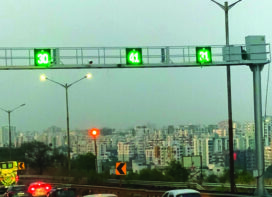He added, “We have Video wall that is being regularly monitored. Every day, around 1000 cases are booked based on the CCTV camera feeds. We have laser-guns for over speeding. This gun can record the speed of the vehicle. Challans are also issued based on the results obtained from the laser guns. It is purely evidence based, so when a challan is issued, we also provide with it the evidences and the recordings.”
Hyderabad has installed fixed surveillance cameras on all 25 cranes across the city. There is a complete accountability for the vehicles which are towed away by the traffic crane. The cameras provide constant feeds that are sent to the control room. With this technology, the police is trying to bring in traffic regulation and enforcement, and much more transparency and accountability.
Traffic Surveillance Project in Chennai
It would be hard to miss the recent additions to the streets of Chennai over the past few months. The ubiquitous presence of tiny flickering lights that belong to the many CCTV cameras placed within 50 metres of each other at most roads and intersections have attracted considerable attention and publicity.
The CCTV cameras are part of an initiative launched two years ago by the Chennai Police to combat crime. Dubbed ‘Third Eye’, the campaign has gained steam over the last six months or so and now covers over half the city.
Mylvahanan, DCP-Traffic, Greater Chennai Police said, “We are installing CCTV units in the city as a movement. It is the Greater Chennai City Police’s project to ensure safety and security of everyone in the city. We are making all-out efforts to bring the entire city under CCTV surveillance.”
 Cameras have now been installed at every major junction and street corners. In many cases they are linked to the police control room of the nearest police station. The unique nature of the Third Eye campaign is the high level of involvement of people from all walks. While some of these have been installed using police funds, some have received MP and MLA local funds while citizens and RWAs have also donated to them for CCTV installation.
Cameras have now been installed at every major junction and street corners. In many cases they are linked to the police control room of the nearest police station. The unique nature of the Third Eye campaign is the high level of involvement of people from all walks. While some of these have been installed using police funds, some have received MP and MLA local funds while citizens and RWAs have also donated to them for CCTV installation.
Private individuals such as shopkeepers, house owners and Resident Welfare Associations have also come forward in great numbers to install street-facing cameras themselves. These cameras are not networked and the data rests with the owners who have installed the camera. In that sense, the Third Eye campaign is one of the largest publicprivate surveillance networks in the country. As part of the ‘third eye’ campaign traffic police have installed at least 10,000 cameras as of now, out of 15,345 as planned.
In first-of-its kind, Hyundai Motor India Limited completed Chennai’s first Traffic Regulation Observed Zone (TROZ), by handing over a bank of 63 sophisticated cameras and a fully equipped monitoring room, set up at a cost of ₹2.5Cr, to the city police. Forty cameras have been exclusively installed to track the number plates of traffic violators, while 18 will provide proof of violation and five cameras will be used for total surveillance enabling the traffic police to take action against offenders.
TROZ was launched by HMIF in March 2018, in association with the Chennai Traffic Police, in Anna Nagar as a pilot project on road safety. To curb traffic violations, including speeding of vehicles along the East Coast Road, the city police have installed high-resolution automatic number plate recognition (ANPR) cameras.
In a bid to curb signal violations on city roads and reduce accidents caused by it, the Chennai Traffic Police is also planning to install RLVD cameras on arterial roads in the coming months. This will be in addition to the ANPR cameras planned at signals.
Till March this year, the traffic police has registered over 37,200 cases relating to signal violations and close to 15,000 cases pertaining to stop-line violation.
 TrafficInfraTech Magazine Linking People Places & Progress
TrafficInfraTech Magazine Linking People Places & Progress


